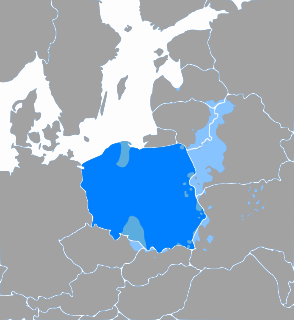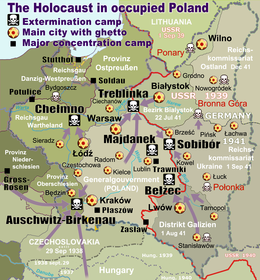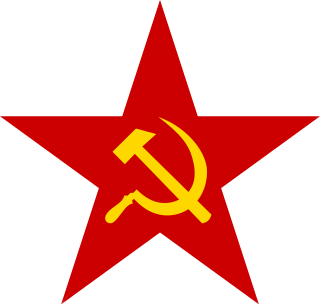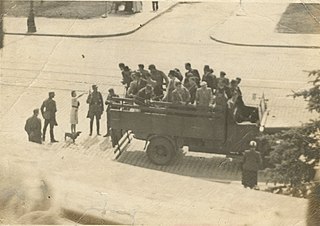
The ghetto uprisings during World War II were a series of armed revolts against the regime of Nazi Germany between 1941 and 1943 in the newly established Jewish ghettos across Nazi-occupied Europe. Following the German and Soviet invasion of Poland in September 1939, Polish Jews were targeted from the outset. Within months inside occupied Poland, the Germans created hundreds of ghettos in which they forced the Jews to live. The new ghettos were part of the German official policy of removing Jews from public life with the aim of economic exploitation. The combination of excess numbers of inmates, unsanitary conditions and lack of food resulted in a high death rate among them. In most cities the Jewish underground resistance movements developed almost instantly, although ghettoization had severely limited their access to resources.

Lutsk is a city on the Styr River in northwestern Ukraine. It is the administrative center of the Volyn Oblast (province) and the administrative center of the surrounding Lutsk Raion (district) within the oblast, though it is not a part of the raion. Lutsk has the status of a city of oblast significance, equivalent to that of a raion. Population: 217,103 (2015 est.)

Olyka is an urban-type settlement in Kivertsi Raion, Volyn Oblast, Ukraine. It is located east of Lutsk on the Putilovka Rriver. Its population is 3,130 (2015 est.).

Beginning with the invasion of Poland during World War II, the regime of Nazi Germany set up ghettos across occupied Europe in order to segregate and confine Jews, and sometimes Romani people, into small sections of towns and cities furthering their exploitation. In German documents, and signage at ghetto entrances, the Nazis usually referred to them as Jüdischer Wohnbezirk or Wohngebiet der Juden, both of which translate as the Jewish Quarter. There were several distinct types including open ghettos, closed ghettos, work, transit, and destruction ghettos, as defined by the Holocaust historians. In a number of cases, they were the place of Jewish underground resistance against the German occupation, known collectively as the ghetto uprisings.

The Lwów Ghetto was a World War II Jewish ghetto established and operated by Nazi Germany in the city of Lwów in the territory of Nazi-administered General Government in German-occupied Poland.

The Holocaust in German-occupied Poland was marked by the construction of death camps by Nazi Germany in Poland. The Third Reich's World War II genocide, known as the Holocaust, took the lives of three million Polish Jews, half of all Jews killed during the Holocaust. Scholars disagree on whether to also classify up to three million ethnic-Polish victims of German genocide as Holocaust victims. The extermination camps played a central role in Germany's systematic murder of over 90% of Poland's Jewish population.

Wołyń Voivodeship or Volhynian Voivodeship was an administrative region of interwar Poland (1918–1939) with an area of 35,754 km², 22 cities, and provincial capital in Łuck. The voivodeship was divided into 11 districts (powiaty). The area comprised part of the historical region of Volhynia. At the end of World War II, at the insistence of Joseph Stalin and the Soviet Union during the Tehran Conference of 1943, Poland's borders were redrawn by the Allies. The Polish population was forcibly resettled westward; and the Voivodeship territory was incorporated into the Ukrainian SSR of the Soviet Union. Since 1991 it has been divided between the Rivne and Volyn Oblasts of sovereign Ukraine.

The Holocaust in Belarus in general terms refers to the Nazi crimes committed during World War II on the territory of Belarus against Jews. The borders of Belarus however, changed dramatically following the Soviet invasion of Poland in 1939, which has been the source of confusion especially in the Soviet era as far as the scope of the Holocaust in Belarus is concerned.

ŁachwaGhetto was a World War II ghetto created by Nazi Germany on 1 April 1942 in the town of Łachwa in occupied eastern Poland, with the aim of persecution, terror and exploitation of the local Jews. The ghetto existed only until September 1942. It was the location of one of the first, and possibly the first, Jewish ghetto uprising following the Nazi–Soviet Invasion of Poland.

The Mizocz Ghetto was a World War II ghetto set up in occupied Poland by Nazi Germany for the forcible separation and mistreatment of Polish Jews. Before the Nazi-Soviet invasion of 1939 the town of Mizocz was located in the Zdołbunów county of the Wołyń Voivodeship in the Second Polish Republic. Mizocz is situated some 18 miles (29 km) east of Dubno, which was the County seat.
Shmuel Shilo or Shmulik Shiloh was an Israeli actor, director and producer, born in the Second Polish Republic, and best remembered for his role on the Israeli production of Rechov SumSum, a popular TV show based on Sesame Street. In 1983 he founded the Negev Theatre and served as its creative director for fifteen years.

Stanisławów Ghetto was a Jewish World War II ghetto established in 1941 by the Schutzstaffel (SS) in the prewar Polish city of Stanisławów in the south-eastern region of Kresy occupied by Germany after Operation Barbarossa. Before the joint Nazi-Soviet invasion of Poland in 1939 Stanisławów was the capital of the Stanisławów Voivodeship in the Second Polish Republic. The Soviets annexed the city to the Ukrainian SSR in 1939 along with the entire region, but renamed it as Ivano-Frankivsk in 1962, long after the war ended. In 1941 Stanisławów was overrun again, this time by the Wehrmacht army, in the course of the German attack on the Russian positions behind the Curzon Line, and incorporated it into their own Distrikt Galizien, as the fifth district of the Generalgouvernement.

The Tarnopol Ghetto was a Jewish World War II ghetto established in 1941 by the Schutzstaffel (SS) in the prewar Polish city of Tarnopol occupied by Germany at the onset of Operation Barbarossa. Before the joint Nazi-Soviet invasion of Poland in 1939 Tarnopol was the capital of the Tarnopol Voivodeship in the south-eastern part of the Kresy macroregion in the Second Polish Republic. The invading Soviets annexed the city in 1939 to the Ukrainian SSR along with the entire province and renamed it as Терно́поль (Ternopol).

The Ghetto in Równe, or the Rovno Ghetto, was a Jewish World War II ghetto established in October 1941 by Nazi Germany in the prewar Polish city of Równe in the territory of Nazi-administered Reichskommissariat Ukraine. On November 6, 1941, about 21,000 Jews of Równe were led to a pine grove in Sosenki by the Ukrainian Auxiliary Police and massacred there by Einsatzgruppe C and their Ukrainian collaborators. The remaining Polish Jews were packed into a Nazi ghetto. Several months later, in July 1942 all 5,000 local Jews were trucked to a stone quarry near Kostopol and murdered there.
The Sarny Massacre was the execution of an estimated 14,000 to 18,000 people, mostly Jews, in the Nazi-occupied city of Sarny, now Rivne Oblast of Ukraine, on August 27 and 28, 1942.

Sambor Ghetto was a Jewish World War II ghetto established in March 1942 by the Schutzstaffel (SS) in the prewar Polish city of Sambor in the south-eastern region of Kresy. In 1939 Sambor was briefly occupied by Germany prior to being handed over to the Soviet Union. In 1941, the Germans captured the town at the beginning of Operation Barbarossa. Before the war, Sambor was a county seat in the Lwów Voivodeship of the Second Polish Republic. The invading Germans handed the town over to the Soviets in accordance with the Nazi-Soviet Pact against Poland. Sambor was annexed to the Ukrainian SSR along with the entire region in the atmosphere of intimidation, and the NKVD terror. In 1941 the city was overrun again by the Wehrmacht army in the course of the German attack on the Soviet positions behind the Curzon Line, and incorporated it into their own Distrikt Galizien. According to the Polish census of 1931 Jews constituted nearly 29 percent of the town's inhabitants, most of whom were killed during the Holocaust. Sambor (Sambir) is not to be confused with the much smaller Old Sambor located close-by, although their Jewish history is inextricably linked together.



































